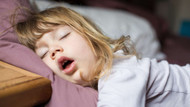Although many people think that obstructive sleep apnoea only occurs in adults, it’s also found in children too.
OSA only affects around 2% - 3% of children, with two to three in every hundred children experiencing some form of obstructive sleep apnoea1.
For children, it’s most commonly caused by enlarged tonsils and adenoids.
Are the symptoms of obstructive sleep apnoea different for children?
Children with obstructive sleep apnoea will often show the following symptoms1:
-
Breathe through their mouth instead of their nose at night
-
Snore loudly
-
Have difficulty breathing while sleeping
-
Have headaches upon waking
-
Have a blocked nose, poor appetite and difficulties swallowing
-
Trouble concentrating at school
Children don’t experience daytime sleepiness whereas adults who are diagnosed with obstructive sleep apnoea do.
For adults, it’s likely that males are going to be diagnosed with sleep apnoea, whereas in children, there’s no specific gender more likely to get sleep apnoea2.
What causes obstructive sleep apnoea in children?
Childhood obstructive sleep apnoea’s most common cause is enlarged tonsils in the back of the throat or enlarged adenoids in the back of the nose3.
It can also be caused by turbinates (small bony structures) in the breathing passage.
Other causes of obstructive sleep apnoea in childhood can include:
-
Small jaws or flat faces
-
Long-term allergies or hayfever
-
Specific medical conditions that are associated with weak muscles, such as Down Syndrome
-
Obesity
You should take your child to your local doctor if you think your child has obstructive sleep apnoea. They may be referred to an ear, nose and throat specialist or a paediatrician.
What kind of treatment is available for my child?
The type of treatment your child needs depends on the severity of their obstructive sleep apnoea diagnosis3.
If they have enlarged adenoids and tonsils, they may need surgery to remove them. Most children’s obstructive sleep apnoea will be cured by the removal of tonsils and adenoids.
If they have a long-term nasal allergy, they may need to trial different medications and treatments, which your doctor will discuss with you.
It’s important to note that if your child is still showing symptoms of obstructive sleep apnoea after they’ve had their tonsils or adenoids removed, tell your doctor as more tests may be needed.
References
1Children’s Health Queensland Hospital and Health Services, Sleep Apnoea, accessed 27 March 2023
2The Royal Australian College of General Practitioners, Sleep apnoea in the child, accessed 27 March 2023
3Royal Children’s Hospital Melbourne, Childhood Obstructive Sleep Apnoea, accessed 27 March

